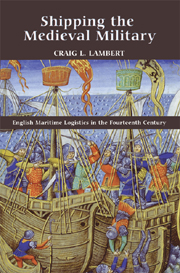Book contents
- Frontmatter
- Contents
- List of Tables
- Acknowledgments
- Abbreviations
- Introduction
- 1 Raising a Fleet
- 2 The Supply of Armies and Garrisons by Sea, 1320–1360
- 3 The Transportation of English Armies to France, 1324–1360
- 4 Maritime Resources and the King's War
- Conclusion
- Appendix 1 Ports that Supplied Ships to the Fleets
- Appendix 2 Reconstructing the Merchant Fleet: A Methodology
- Bibliography
- Index
- Warfare in History
Appendix 2 - Reconstructing the Merchant Fleet: A Methodology
Published online by Cambridge University Press: 12 September 2012
- Frontmatter
- Contents
- List of Tables
- Acknowledgments
- Abbreviations
- Introduction
- 1 Raising a Fleet
- 2 The Supply of Armies and Garrisons by Sea, 1320–1360
- 3 The Transportation of English Armies to France, 1324–1360
- 4 Maritime Resources and the King's War
- Conclusion
- Appendix 1 Ports that Supplied Ships to the Fleets
- Appendix 2 Reconstructing the Merchant Fleet: A Methodology
- Bibliography
- Index
- Warfare in History
Summary
The methodology that has been used to calculate the individual ships in Table 4.2 was achieved by matching three ‘identifiers’ that the sources consistently provide. Thus, if a particular ship name from a certain port appears with the same master in the records of more than one expedition it is counted once. As such Table 4.2 takes account of those ships and masters that we know served on more than one occasion. This method can still give rise to both overestimates and underestimates of vessel numbers, due to double counting and unidentified linkages. To compensate for this we can analyse the repetition of ship names from certain ports. Those ships sailing in the same fleet with the same name would provide a minimum number of ships with that name sailing from that port. Finally, we can also assess the repetition of service amongst shipmasters. A large number of masters serving repeatedly would suggest that the merchant marine was small, whereas a small number of repeat servers would argue for a large pool of shipmasters, and thus a larger merchant marine. This methodology in its simplest form would be as follows: Robert Tynwit, a shipmaster from Great Yarmouth, operated the same ship, the Nicholas, on three separate occasions. This, of course, could be three individual ships, all with the same name, which would mean the individual ship totals in Table 4.2 would be underestimates.
- Type
- Chapter
- Information
- Shipping the Medieval MilitaryEnglish Maritime Logistics in the Fourteenth Century, pp. 215 - 222Publisher: Boydell & BrewerPrint publication year: 2011



